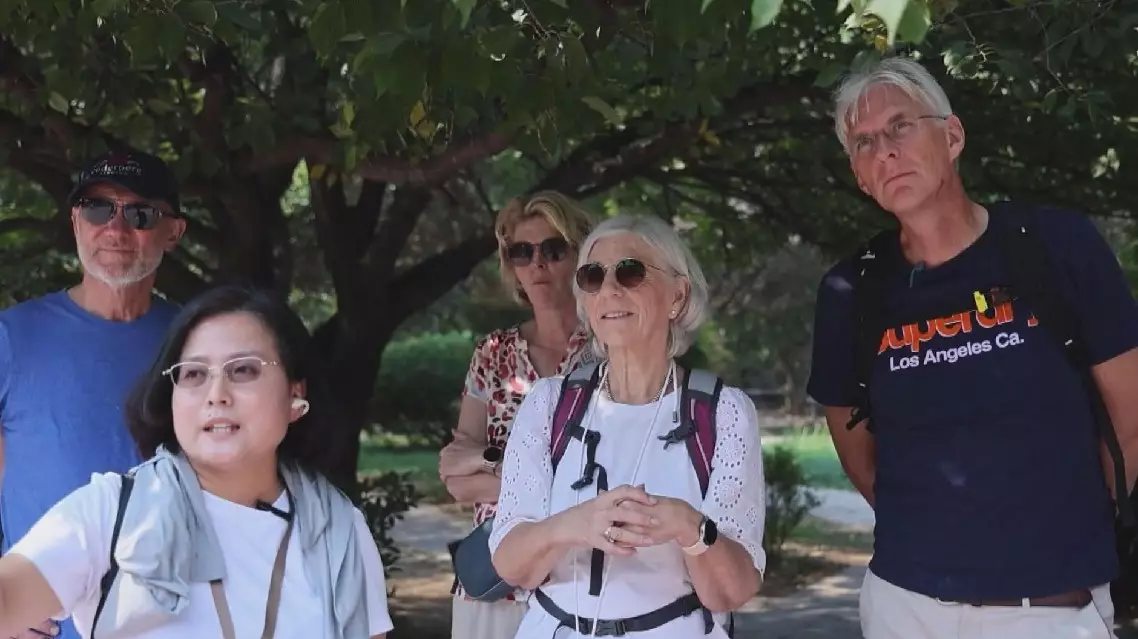A co-produced film by China and some Belt and Road Initiative (BRI) partner countries including Iran and Kazakhstan will hit the big screen this month, which serves as a potent evidence highlighting cultural exchanges and cooperation between China and nations along the route.
The film, "Chang'an, Xi'an", tells a romantic story between a Chinese man and a Kazakh woman. A peer review and seminar on it was held in Beijing on Friday. The film is yet to be released for the public, but the main production team, Chinese officials, film professionals and foreign diplomats from BRI partner countries gathered for a preview and to have a discussion on the film.
Abu-Talip, the counselor of Embassy of Kazakhstan in China was also one of the guests present at the seminar. He shared his thoughts on China-Kazakhstan relationship, and how the movie relates to it.
"The film we watched today is about the friendship between the people of our two countries. In reality, through the ancient Silk Road, China and Central Asian countries had close exchanges since ancient times. In modern times, projects such as the cultural centers established by China and Kazakhstan demonstrate the strong friendship between the two nations," said Abu-Talip.
As a plotline, this film tells the love story of a Chinese man and a Kazakh woman. But it also has deeper connotations -- attempting to showcase the unique cultures and exchanges among the BRI partner countries.
"We wanted to tell our stories through people. So, we focused on one individual to convey the grand context of the Belt and Road Initiative and the concept of a community with a shared future for mankind. This is one of the key features of the movie," said Zhang Zhong, the director of the movie.
The main actress, Alima, is of Kazakh ethnic minority in China -- having a deep connection with the main ethic group in Kazakhstan. She says she still has to do a lot of work to act her part as an international student from the country.
"I have always lived in China, but I once traveled to Kazakhstan. During that trip, I realized that although we might have belonged to one ethnic group in ancient times, there are still quite a few differences in our living habits and languages. For the movie, I had to learn the Kazakh way of saying many words," she said.
Trade and communication among China, Iran and Central Asian countries started since the ancient times. Nowadays, through platforms such as the BRI, these countries aim to further deepen communication, including sharing creativity and culture through films.

Co-produced film showcases cultural exchanges among China, BRI countries
An increasing influx of elderly overseas travelers now choose to spend some of their post-retirement time traveling in China as the country keeps improving its visa policies and tourism services.
With more elderly travelers coming to China from abroad, the country's inbound tourism market has experienced significant growth. In the first seven months of this year, the country received about six million visits from foreign travelers, marking an over-400-percent increase year on year, according to the Ministry of Culture and Tourism of China.
Six Dutch tourists recently visited Xi'an City in northwest China's Shaanxi Province to see the terracotta warriors at the site of Emperor Qin Shihuang's Mausoleum.
They are all above the age of 60 and most of them came to China for the very first time. Wilco Poppeliers, one of the travelers, said he has long been expecting this travel and he could only make it after his retirement.
"I think it was very [much] on my bucket list still to visit China. Now I'm retired, I have the time to travel to visit places like this," he said.
For elderly couples from Mongolia, Chinese destinations also maintained strong attraction. Altogether 12 of them have an average age of about 60, with the oldest already 88.
"China is just next to Mongolia. I have visited many places in China like Wutaishan, Zhangjiajie, Hohhot, and Beijing. China has been developing very fast," said one of the tourists.
Along the Lijiang River, famous for its karst landscapes, some 30 overseas tourists recently visited the riverside Moya cliff sculptures and inscription.
The elders said they have been traveling around China before arriving at the cliff site in the southern city of Guilin, Guangxi Zhuang Autonomous Region.
"We have traveled around the country and visited a wide range of cities. The travels were very smooth and convenient," said Marcia Akemi Fujinami, a visitor from Brazil.
The rich cultural heritage is what attracts him to China, said Fabrizio, an Italian tourist, adding that visiting the country has been easier as now there are many flights between Europe and China.
"Traveling to China is nowadays quite simple. There are a lot of flights coming from Europe. China is one of the countries with the largest number of UNESCO heritage places in the world. So we are very happy about visiting this country," he said.
China has been promoting inbound travels by accelerating the resumption of flights and improving tourism services for travelers from abroad. Scenic spots across the country have also been facilitating visits for international tourists while enhancing the quality of their products.
With improved visa policies, customs clearance policies, and more payment options, including cash payment, QR code and bank cards, overseas visitors can now enter and enjoy better services in China.

China sees increasing elderly overseas tourists following improved policies, services










